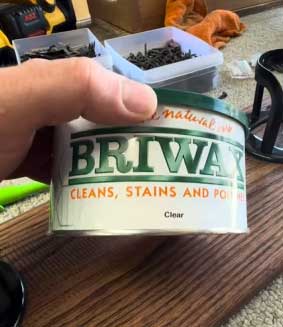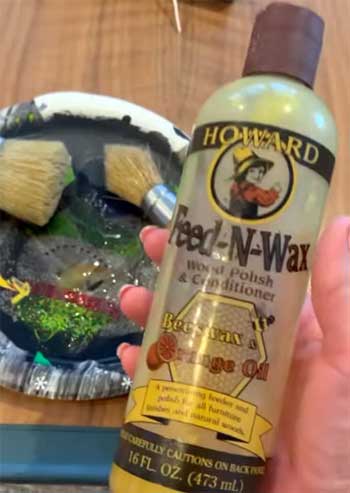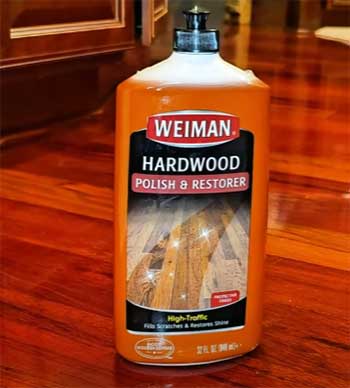Let me tell you something—Briwax is the secret weapon your wooden furniture and floors have been begging for. Seriously, if you’re tired of dull surfaces or scratched-up tabletops, this stuff is a game-changer.
I stumbled across this gem when I was desperate to revive my old kitchen cabinets without slapping paint on them, and let me just say, it’s worth every penny. Whether you’re a furniture restoration pro or just someone who loves a good DIY glow-up, trust me—you need Briwax in your life.
Stick with me, and I’ll walk you through why it’s a must-buy.
My Briwax Adventure

Picture this: I’m staring at my 30-year-old kitchen cabinets, worn out from decades of use, and I’m torn.
Do I paint them and risk losing that warm, woody charm?
Or do I try something else? That’s when Briwax entered the chat.
I snagged the Light Brown 16oz can—perfect for my honey-toned wood—and decided to give it a whirl.
I wasn’t expecting miracles, but holy cow, was I in for a surprise.
First off, the application was a breeze. I grabbed a soft cloth, scooped out a bit of that creamy wax, and started rubbing it into the cabinets. It’s got this satisfying texture, like a thick paste that just melts into the wood.
I could feel it soaking in, filling those little scratches and nicks as I went. I decided to get adventurous and layered on some Rustic Pine over the Light Brown for a richer vibe—total mad scientist move, but it worked!
After about 10 minutes of letting it sit, I buffed it with another cloth, and boom—my cabinets looked like they’d just rolled off the factory line, but with soul intact.
Then there was my antique coffee table, a 90-year-old relic with a shellac finish that had seen better days. I was nervous—would Briwax mess up that vintage patina? Nope. I smoothed it on, and within minutes, it was gleaming again, scratches blended into the grain like they’d never existed.
My friends couldn’t stop complimenting it, asking if I’d secretly swapped it for a new one. The best part? It didn’t just shine—it felt protected, like I’d armored it against fingerprints and spills.
Now, I won’t sugarcoat it: the smell hit me like a freight train when I opened the can. It’s got this sharp, chemical kick—think solvent city. I cracked a window, popped on a mask, and kept my dog out of the room while I worked.
But here’s the kicker—it faded fast. By the time I was done buffing, the air was clear, and all that was left was this gorgeous, lustrous finish staring back at me. That first experience sold me—I’m a Briwax believer for life.
Pros of Briwax: Why I’m Obsessed?
Let’s talk about what makes Briwax so darn awesome. I’ve used it enough now to know it’s not just hype—it delivers. Here’s why I can’t stop singing its praises.
- Killer Shine Without the Gloss Overload

You know how some waxes leave your wood looking like a shiny plastic toy?
Not Briwax.
This stuff gives you a lustrous patina—a deep, rich glow that screams class, not over-the-top gloss.
My floors?
They shine like a dream, catching the light just right without looking like I lacquered them to death. It’s the kind of finish that makes people go, “Wow, your place looks amazing,” without even knowing why.
- Versatility Is Its Middle Name
I love how Briwax wears so many hats. It’s not just a finish—it’s a reconditioner, a furniture wax, and even an antiquing agent if you’re feeling artsy. I used it on new wood shelves to give them that broken-in vibe, then flipped to my beat-up dining table to smooth out years of wear.
Got a scratched-up antique? It’s got you. Want to “age” a fresh project? Same deal. It’s like the Swiss Army knife of waxes.
- Protection That Packs a Punch
Here’s the real magic: Briwax doesn’t just sit there looking pretty—it protects. I’ve noticed how it keeps oils and salty fingerprints from marring my surfaces. My kitchen table, once a magnet for smudges, now shrugs them off like a champ.
It’s a blend of beeswax and carnauba wax, so it’s tough as nails while staying natural. I feel like I’ve given my furniture a shield without compromising its vibe.
- Scratch and Nick Ninja
Got scratches? Briwax is your new best friend. On my honey-toned table, it filled in little holes and blended them into the darker oak grain like a pro.
I didn’t need sandpaper or elbow grease—just a quick swipe and a buff, and those imperfections vanished. It’s not a cover-up; it’s a seamless fix that makes your wood look whole again.
- Easy-Peasy Application
I’m no pro, but Briwax makes me feel like one. You don’t need fancy tools—just a cloth and a little effort. I slap it on, let it chill for a few minutes, and buff it out. Ten minutes tops for my tabletop, and I’m done. It’s so simple, you’ll wonder why you ever bothered with complicated finishes.
Cons of Briwax: The Not-So-Perfect Bits
Okay, let’s keep it real—Briwax isn’t flawless. I’ve run into a couple of hiccups that might bug you too. Here’s what I’ve noticed.
- Fumes That’ll Clear the Room

That solvent smell I mentioned?
Yeah, it’s no joke.
When I first cracked open the can, it was like a chemical punch to the face.
I had to mask up and fling open every window in sight.
My pets were banished to the backyard until it aired out.
It fades quick—give it 15 minutes post-buffing—but if you’re sensitive to odors, this could be a dealbreaker.
- Not a One-Coat Wonder
Sometimes, I’ve had to layer it on twice to get the coverage I want. On my darker oak pieces, one coat didn’t quite cut it—scratches still peeked through until I doubled up.
It’s not a huge hassle, but if you’re hoping for a lightning-fast fix, you might need to adjust your expectations.
- Color Commitment Can Trip You Up
Picking the right shade—like Light Brown—takes some guesswork. I got lucky with my cabinets, but if you go too dark or too light, it might not blend as well as you’d hope. I’ve heard folks say the tinted waxes can be lightened with clear wax, but that’s extra work I’d rather skip.
Test it on a small spot first, trust me.
Maintenance Tips: Keeping Your Briwax Game Strong
Briwax isn’t a set-it-and-forget-it deal—you’ve got to maintain it to keep that magic alive. Here’s how I’ve learned to make it last and keep my wood looking top-notch.
- Buff It Like You Mean It: After applying Briwax, don’t skimp on the buffing. I grab a clean, soft cloth and go to town, working in circles until it shines. It’s not just for looks—it seals the wax in, making it tougher against wear. I buff my table every few weeks to keep it fresh, and it’s like a mini workout with a gorgeous payoff.
- Reapply When It Fades: You’ll know it’s time to re-wax when the shine dulls or scratches start popping up again. For me, that’s about every six months on high-traffic spots like my floors. I wipe the surface down with a damp cloth first to clear dust, then slap on a thin layer. It’s quick, and your wood will thank you with that “just-waxed” glow.
- Keep It Clean, But Gentle: Don’t go crazy with harsh cleaners—Briwax doesn’t vibe with that. I use a damp cloth with a tiny bit of mild soap for spills or smudges, then dry it fast. Anything stronger might strip the wax, and then you’re back to square one. Treat it like the delicate gem it is.
- Store It Right: That can of Briwax? Keep it in a cool, dry spot. I left mine in the garage once, and the heat turned it into a gooey mess—still usable, but a pain to scoop out. Room temp is your friend, and make sure the lid’s tight so it doesn’t dry out.
- Watch the Humidity: Wood and wax don’t love moisture overload. In my humid kitchen, I’ve noticed the finish can get tacky if I don’t ventilate. Run a fan or dehumidifier if your space gets muggy—it’ll keep Briwax from sweating and losing its edge.
Briwax Vs. The Competition: A Showdown Worth Reading
Alright, let’s put Briwax in the ring with some other heavy hitters—Howard Feed-N-Wax, Scott’s Liquid Gold, and Weiman Hardwood Polish and Restorer. I’ve given these a spin on my furniture and floors, and I’m here to break down how they measure up to my beloved Briwax Light Brown.
No fluff, just real talk from someone who’s wiped, buffed, and sniffed them all. Here’s how they stack up, one-on-one.
- Briwax Vs. Howard Feed-N-Wax: The Nourishment Battle

First up, Howard Feed-N-Wax. This stuff’s all about feeding your wood with a mix of beeswax, carnauba, and orange oil.
I slathered it on my old oak dresser, and it drank it up—left a nice, soft sheen and a citrusy whiff that’s way friendlier than Briwax’s solvent punch.
It’s a breeze to apply, just wipe and go, no heavy buffing needed.
But here’s where Briwax flexes: it’s got more grit for hiding scratches and filling nicks.
Howard smoothed things out but didn’t erase imperfections like Briwax did on my beat-up table.
Plus, Briwax’s finish feels tougher—Howard’s more of a light conditioner, fading faster under daily use (think three months vs. Briwax’s six). If I want deep protection and a richer patina, Briwax wins. For a quick nourish-and-shine, Howard’s your guy.
- Briwax Vs. Scott’s Liquid Gold: The Scented Showdown

Next, Scott’s Liquid Gold—a classic that’s been around forever. I poured some on a rag and hit my cherry coffee table with it.
The almond scent?
Heaven compared to Briwax’s chemical kick—I didn’t need a mask or an open window.
It spreads like butter, soaking in fast with a warm, subtle glow.
But it’s thinner than Briwax, more of a polish than a wax.
Scratches?
It softened them but didn’t fill them like Briwax’s paste magic.
Scott’s also leans glossier, which I’m not wild about—Briwax’s lustrous vibe feels classier.
Durability-wise, I’d give Briwax the edge; Scott’s shine dulled in a couple months, while Briwax holds strong longer. If you’re after easy application and a sweet smell, Scott’s tempts me. For lasting power and scratch repair, Briwax keeps the crown.
- Briwax Vs. Weiman Hardwood Polish and Restorer: The Glossy Grudge Match

Finally, Weiman Hardwood Polish and Restorer.
I tested this on my scratched-up hardwood floors, and it’s a spray-and-wipe dream—covers big areas fast with zero elbow grease.
The finish?
Glossy and slick, almost too shiny next to Briwax’s understated charm.
It hid light scuffs well, but deeper scratches stayed put—Briwax tackled those like a champ on my table.
Weiman’s got a mild, clean scent, nothing like Briwax’s fume fest, which I appreciated. But it’s not a wax; it’s a polish, so protection feels flimsier—fingerprints showed up quick, and it needed redoing in a month.
Briwax, with its beeswax-carnauba duo, builds a sturdier shield. Weiman’s great for a fast floor refresh, but for furniture or lasting oomph, Briwax outmuscles it every time.
Frequently Asked Questions (FAQ)
From my experience, Briwax holds up for about six months on stuff like tables and floors that see daily action. In quieter spots—like my antique dresser—it’s stretched closer to a year before needing a touch-up. It depends on wear and tear, but buffing and reapplying keep it going strong.
Side effects? Well, it’s mostly that pungent solvent smell while you’re applying it. I’ve had no issues with the finish itself—no skin reactions or pet problems once it dries. Just don’t huff the fumes—ventilate, and you’re golden.
Oh, absolutely! I slapped it on my 30-year-old cabinets, and they went from drab to fab. It fills scratches, protects against spills, and gives a warm glow that fits any kitchen vibe. Just reapply every few months if your kitchen’s a war zone like mine.
Minwax Paste Wax and the late Johnson Paste Wax are the closest I’ve found. Minwax is lighter and needs more coats, while Johnson was glossier and super durable. Briwax sits in the sweet spot—rich, versatile, and not too shiny. It’s my pick over both.
Conclusion: Seal The Deal With Briwax
So, there you have it—Briwax is the real deal, and I’m telling you, you’ve got to get your hands on it. It’s transformed my furniture and floors into something I’m proud to show off, and it’ll do the same for you.
From its killer shine to its scratch-hiding powers, it’s a no-brainer buy.
Sure, it’s got a funky smell and takes a little upkeep, but the payoff? Totally worth it. Grab that Light Brown 16oz can and see for yourself—you won’t regret it.
